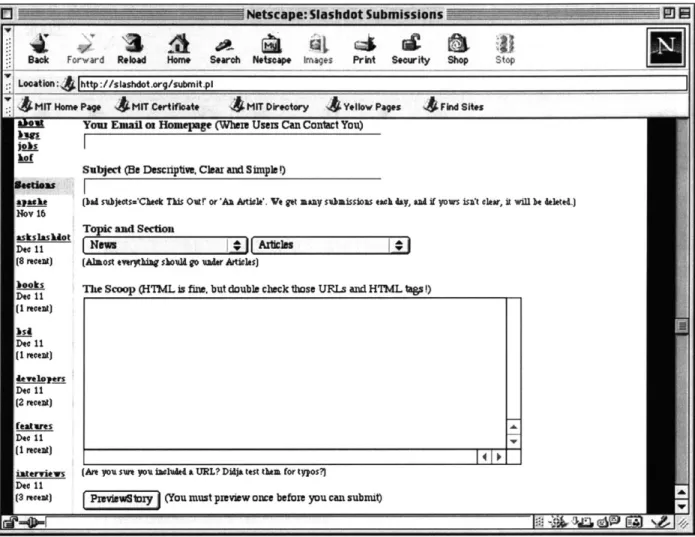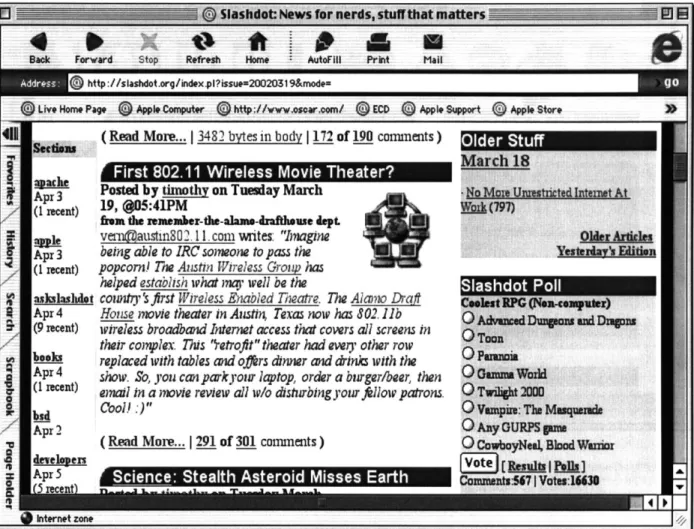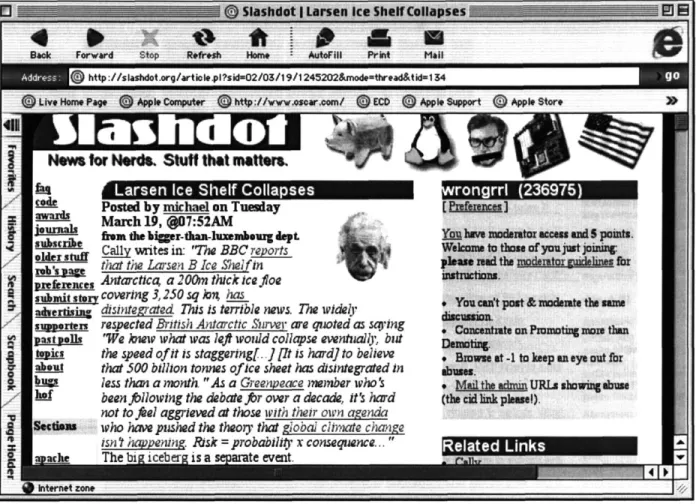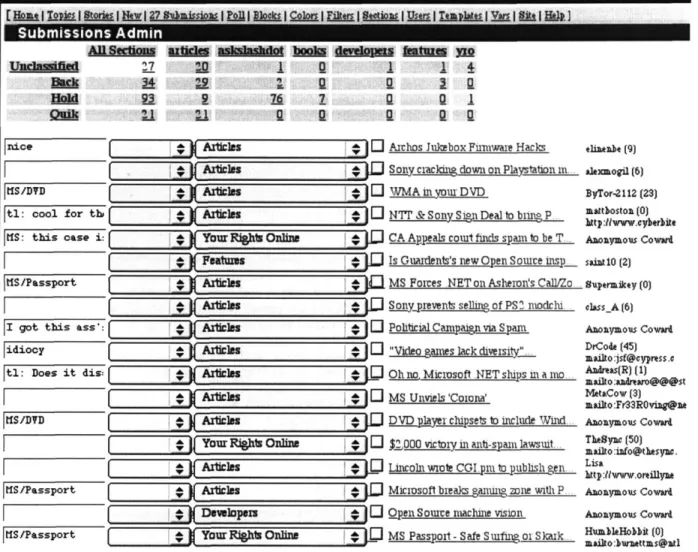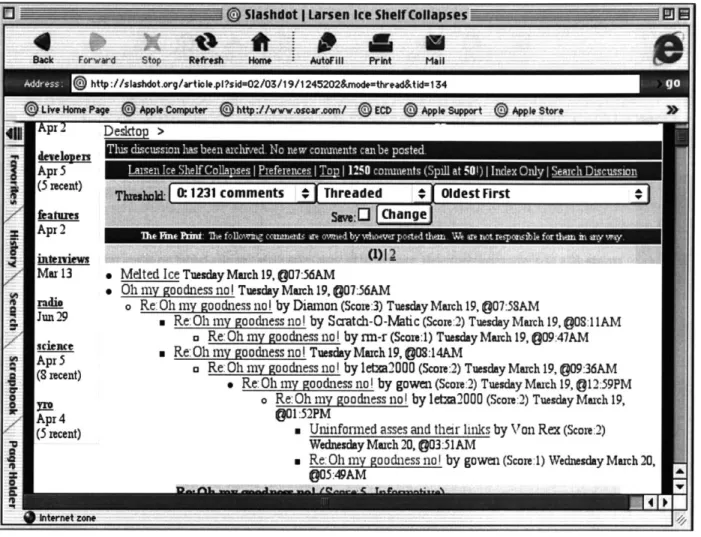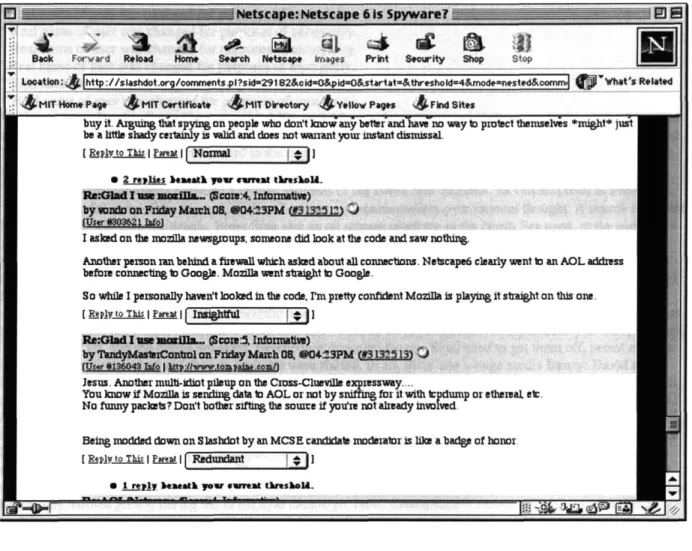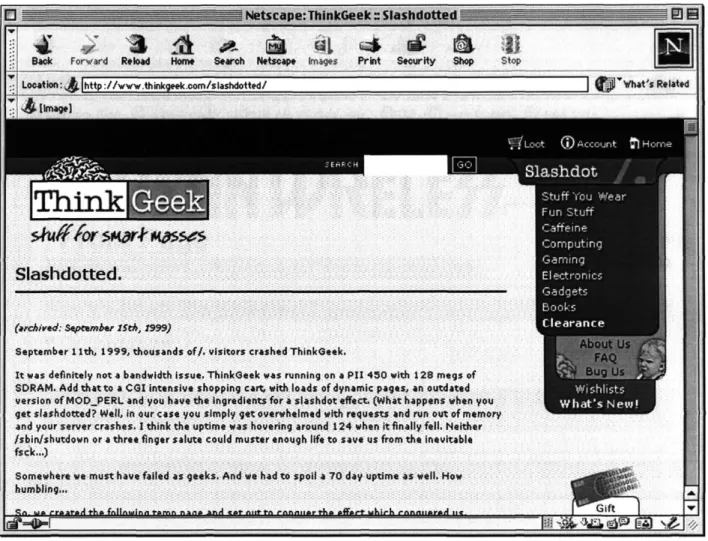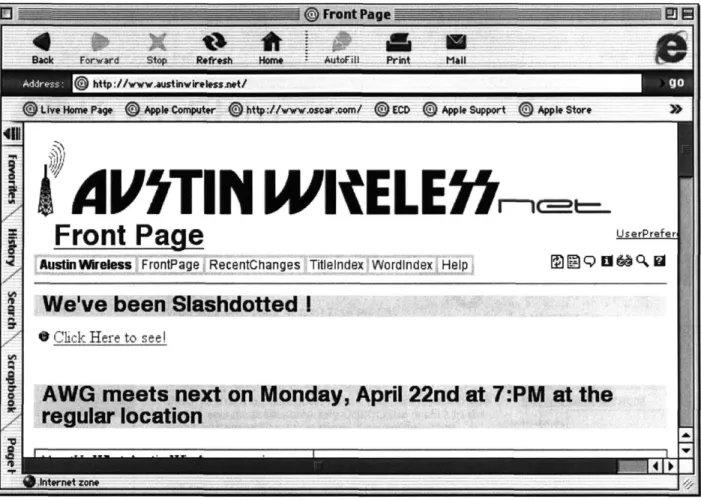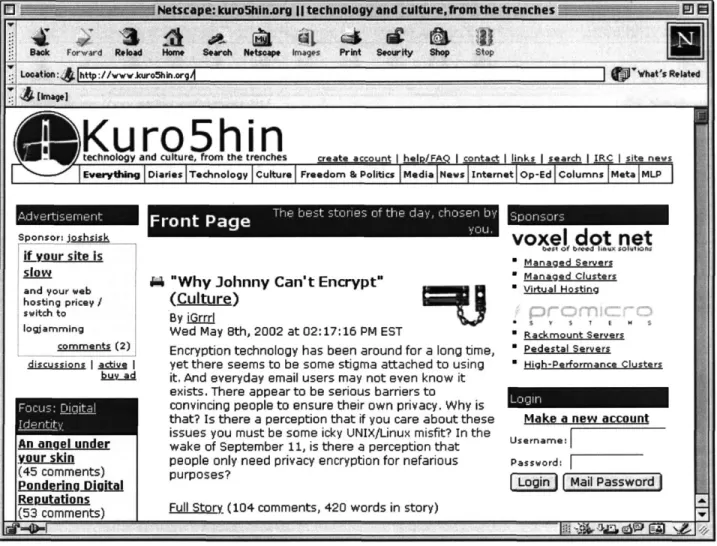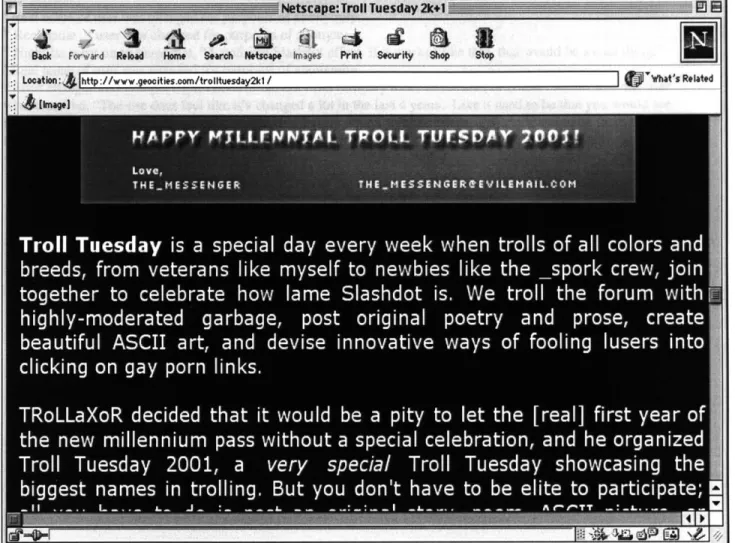by Anita J. Chan
B.A. Journalism, Women's Studies New York University, 1998
SUBMITTED TO THE DEPARTMENT OF COMPARATIVE MEDIA STUDIES IN THE PARTIAL FULFILLMENT OF THE REQUIREMENTS FOR THE DEGREE OF
MASTER OF SCIENCE IN COMPARATIVE MEDIA STUDIES AT THE
MASSACHUSETTS INSTITUTE OF TECHNOLOGY JUNE 2002
@2002 Anita J. Chan. All rights reserved.
The author hereby grants to MIT permission to reproduce and to distribute publicly paper and electronic copies of this thesis document in whole or in part.
Signature of Author: (;-Certified by:
ARCHIVES
MAS0ACHUSElS ifNSTITUTE OF TECHNOLOGYOCT 0 2 2002
LIBRARIES~ Anita J. Chan March 20, 2002 Joseph Dumit Associate Professor of Science, Technology and Society Thesis SupervisorAccepted by:
o
%" Henry Jenkins Ill
Professor of Literature/n6 Coarative Media Studies
Chairman, mittee for Graduate Students . .. a .% a
Collaborative News Networks: Distributed Editing, Collective Action, and the Construction of Online News on Slashdot.org
by
Anita J. Chan
Submitted to the Department of Comparative Media Studies on May 20, 2002 in the partial fulfillment of the requirements for the degree of Master of Science in
Comparative Media Studies.
ABSTRACT
The growth and spread of the Internet have generated new possibilities for public participation with news content, forcing news scholars and makers alike to confront a number of questions about what the nature, role and function of news, journalists, and audiences are in a networked society. If news gathering, reporting, and circulation had existed for generations as a largely centralized process, left to the minds and hands of reporters organized through news rooms across the nation, the environment of the Internet and interactive properties of new media counter such a model, affording users with as much capacity to produce their own news content as they have had to merely consume it.
This thesis, then, seeks to contribute to scholarship on online journalism through an ethnographic study of the five-year-old, technology-centered news site Slashdot.org as an emerging model of online news production and distribution I call a collaborative new network. Embodying a pronounced case of the decentralization of editorial control in online news environments, Slashdot's collaborative news network operates through an inscription of users as the primary producers of news content; an expansion of an understanding of the site of news to include not just journalistic reports and articles, but the discussion by users around them; debate around issues of editorial authority; a valuation of subjectivity and transparency as properties of news; and the generation of
user-driven forms of collective action whose effects extend beyond the environment of Slashdot's network.
This study will focus, then, on an examination of the social practices and processes surrounding the production, consumption and distribution of news on Slashdot, and the meanings that are generated through such activities. Through such an analysis, I hope to explore how practices enacted on Slashdot (re)construct users' relationship to news, editors, and one another - and similarly investigate how it (re)constructs editors
relationship to news, readers, and one another.
Thesis Supervisor: Joseph Dumit
Many thanks to the users and editors of Slashdot who generously took the time to speak to me -- sharing their stories and experiences by phone, by email, in their homes,
offices, and area cafes, with an otherwise strange and anonymous researcher. Without their honesty and frankness, this work would obviously never have been completed.
My appreciation goes out to Slashdot's editorial team in particular - Rob Malda, Jeff
Bates, Timothy Lord, Michael Sims and Cliff Wood - whose imagination and dedication to Slashdot makes work such as this one possible - and whose humor and insight, as significantly, make work such as this one a pleasure to conduct.
Many, many thanks as well to Joe Dumit, Pablo Boczkowski, Frederick Turner, and William Uricchio, whose intellectual guidance, patience and support invaluably contributed to the shaping of this study in all its various stages and articulations. I'm endlessly fortunate to have been able to work with each, as individuals and collectively as a team. One would be hard-pressed to find a keener set of eyes with which to search out gaps and bridges of thought, discover fresh problems and raise new challenges.
My gratitude goes out to Henry Jenkins of the Comparative Media Studies Department
at MIT, whose vision with CMS and tireless commitment to its students and staff never fails to inspire.
My thanks as well to the CMS graduate students, class of 2002 - Candis, Daniel,
Sophie, Elin, Qi, Margaret, and Michelle - who supplied ample and vital doses of critique, silliness, and mid-thesis snacks upon request.
Thanks, for what are often the things I most take for granted, to my family - Mom, Roger, Rosie, Grandpa and Grandma - whose spirit and warmth, from all their various corners of the planet, have guided all that I am and do.
dAnd, finally, my deepest thanks to Avijit Ghosh, sparring partner, personal editor, and pillar of support, who first set my eyes upon Slashdot, and who has never failed to keep the world fresh, intriguing and brimming with a sea of new curiosities.
TABLE OF CONTENTS
C hap 1: Introduction ... 5
Exploring Collaborative News Networks ... 8
Slashdot: Users, Uses, Utilities ... 12
Defining and Debating "News" on the Network ... 16
Slashdot as a Collaborative News Network ... 26
Chapter 2: Active Users and the Collaborative Construction of News... 35
Social Constructivism, Users, and News Production... 38
Users as Story Sources: The Submissions Bin ... 40
Segregating Audiences and News Sourcing ... 44
Integrating Users as News Sources ... 47
Users as News Critics: Discussion Forums and Moderation... 50
Segregating Audiences and News Analysis ... 55
Integrating Audiences and News Analysis ... 56
Reading News through Discussior...59
Transforming the User-News Relationship ... 62
Chapter 3: Distributed Editing and the Decentralization of Editorial Control ... 73
Heterarchy and the Polyphony of Editorial Styles... 75
Hierarchy, Conformity and Control in News Production... 77
Collaborative News Networks as Heterarchy ... 83
Submissions Bin: The Diversification of Editorial Styles... 85
Submissions Bin: Negotiating User Interests ... 90
From Objectivity to Openness in News ... 95
Building Accountability among Producers ... 99
Chapter 4: Community, Contest and Collective Action on the Network ... 107
Approaching News Production as Collective Action... 113
Representing Tactics of Collaborative News Networks... 117
Network Activism as Collective Action ... 120
Network Effects as Collective Action ... 127
Network Divisions as Collective Action ... 134
Network Protest as Collective Action ... 136
Collaborative News Networks: Distributed Editing, Collective Action, and the Construction of Online News on Slashdot.org
Chapter One: Introduction
Early in October 1999, Johan Ingles-le Nobel, the editor of the international defense and security journal Jane's Intelligence Review, decided to cancel the publication of an article on cyberterrorism planned for its following edition. It was a small blip in the history of journalism that would likely have gone unnoticed, if not for the unique circumstances surrounding the article's retraction - specifically that it came shortly after Ingles-le Nobel submitted the Jane's article for posting to the online technology news discussion and community site Slashdot.org (www.slashdot.org) to solicit feedback from the site's readers on its quality. (Slashdot.org, 1999, October 4) Though just two-years-old at the time, Slashdot had become a virtual meeting grounds for thousands of technology enthusiasts who routinely read the site's daily updated log
of "news for nerds." Asking readers to "keep it clean and stay objective" in their replies,
Ingles-le Nobel's submission appeared among the fifteen stories that were posted to the site that day, nestled between a post on the release of the Red Hat's release of version 6.1 of its Linux-based operating system and another on Australia's tech industry's support of child-appropriate content regulation.
Within hours, more than 250 responses to the article, the majority of them disapproving, were posted to Slashdot. One reader observed, "the article is definitely making a mistake in bunching together Cyber threats and CBRN [chemical, biological, radioactive, and nuclear attacks]. They are different... in all possible ways except in that they are [both] relatively new threats." Another commented, 'The tone is unreasonably alarmist. It makes no distinction between cyberterrorism, which is an attack upon C31 (command, control, communications & intelligence) systems, both military and civil, and terrorists using their own cyber C31." And another quipped, 'The intense focus on 'shut down the power grid' scenarios, and the tight
Chap. 1: Collaborative News Networks, Chan
analogies [between cyber terrorism] with physically violent techniques [such as chemical, biological, radioactive, and nuclear attacks] ... serve only to ignore much more potentially effective uses of IT in terrorist warfare: intelligence-gathering, counterintelligence, and
disinformation. The article does not touch on these points at all, and quite frankly is worthless sensationalism without them."
Alarmed but grateful for the response he had received from Slashdot's readers, a second post from Ingles-le Nobel appeared on the site three days later. (Slashdot.org, 1999, October 7) In it, the Jane's editor specified that in addition to the commentary posted to Slashdot, he had received an additional 35 personal emails from readers of the site who represented professions as diverse as "psychologists to network analysts, and from Sun engineers to Cambridge Dons." Thanking Slashdot's readers for their critiques and
contributions, Ingles-le Nobel wrote, "The responses have been insightful and knowledgeable, with many excellent points made. I've even had a lot of 'thank-you' type letters from computer security professionals for trying this approach... And since roughly 99% of the posters slammed the article... I've informed the author that we're not going to run with it." Instead, Ingles-le Nobel stated, an entirely fresh piece would be printed in the December issue that would incorporate material and suggestions from Slashdot readers.
Within days of Jane's decision to retract the original article, a heated debate erupted within the mainstream reporting community. Career journalists like PBS Online columnist and Silicon Valley documentarian Robert X. Cringley accused Jane's editor of sanctioning "the censorship of the nerderati," (Cringley, 1999, October 7) and of "[throwing] his cyberterrorism research at the nerds who read Slashdot, hoping for some inexpensive proofreading to keep Jane' from making their own big mistakes." Continuing his rebuke in his weekly column 'The
write the news is to write the news. You have to do it the best that you can then take the heat... That's why newspapers make corrections."
If Cringley problematized Jane's unorthodox measures in news editing, insisting that news production remain the exclusive domain of professional journalists, however, others read the move as significantly less troubling. Rich Jaroslovsky, the managing editor of the Wall Street Journal Interactive Edition and president of the Online News Association, defended the
decision, disputing that any act of censorship had been committed since the original article had been made public in its publishing on Slashdot, "which is just as real an act of 'publishing' as publishing it on its own site, or pages." He added that editors had a right to withhold publication of an article "until [their] doubts [about it] are satisfied." (Moon, 1999, October 10) Salon.com senior correspondent Andrew Leonard voiced further support of Jane's method in his own weekly column, citing Slashdot as "a new kind of journalism," that "provides great value simply" in aggregating the "expertise" of its readers. (Leonard, 1999, October 8) Emphasizing the service that news audiences might provide news professionals, Leonard added, 'The Jane's incident takes Slashdot's evolution one major step forward. Slashdot readers are now actively shaping media coverage of the topics... They are helping journalists get the story right, which is a far cry from exerting censorship."
While the controversy surrounding the Jane's decision has since simmered, the question over the position and state of online journalism, and what precisely the implications are of the "new kind of journalism" Slashdot embodies, continues to press news workers, scholars and publics alike. For with the growth and expansion of online journalism have come new
possibilities for public interaction with news content, forcing scholars and professionals to confront a number of questions about what the roles and functions of news, journalists, and audiences are in a networked society. If news gathering, reporting, and circulation has existed for generations as a largely centralized process, left to the minds and hands of professional
Chap. 1: Collaborative News Networks, Chan
journalists working in news institutions across the nation, the environment of the Internet and interactive properties of new media introduce changes to such a model, affording users with as much capacity to produce their own news content as they have had to merely consume it.
At the heart of the issue then, is a dilemma over what will happen to the authority, objectivity and value of journalism when the functions of reporting, editing, verifying and
distributing news are no longer left to the operations of newsrooms alone, but can be dispersed over a largely unrestricted body of anonymous users. Crucial, as well, for many scholars and professionals of news is the question of what will happen to a public served by and purportedly dependent on the trustworthiness of news if the shared traditions and standards of the
journalistic profession no longer collectively apply. Such disputes over the implications of online news then, involve not only issues of what implications new media properties will have on the production, distribution and content of traditional news, but rather crucially center on questions of how users themselves, through social practices enabled by new technologies, are re-shaping the definition of news, newsmaking, and expertise.
Exploring Collaborative News Networks
This study seeks to contribute to the scholarship on online journalism through an exploration, informed by ethnographic methods, of Slashdot as an emergent model of online news production and distribution enabled by what I shall refer to as a collaborative news network. Operating with minimal editorial staff, and often run independently from any established news organization, collaborative news networks are a unique manifestation of online journalism in their reliance on a large, physically dispersed and anonymous body of site users to produce the nearly all news content. What new practices, roles and relationships emerge from users and editors of the site through participation in a collaborative news network,
and how such emergent practices may impact a larger social world beyond the network itself is part of what this thesis seeks to begin to unravel.
Drawn in part from Walter Powell's notion of network organizations (Powell, 1990), collaborative news networks operate through internal structures and logics distinct from
traditional news organizations that attempt to maximize internal order by enforcing a hierarchical system of control and establishing standards in production practices. In network organizations, "transactions occur neither through discrete exchanges nor by administrative fiat, but through networks of individuals engaged in reciprocal, preferential, mutually supportive actions." (p. 333) Unsurprisingly, as well, the concept of a collaborative news network draws from the notion of a computerized network, through which users, working from devices interconnected in a system of cables and lines, can share resources, swap information, and communicate from distinct points with in the structure. News and information can flow, in such a system, from a multiplicity of origins and authors along any number of paths, changing in content and meaning as it does so. Unlike mass media's streamlined architecture, where information is directed from a single point of origin, maintaining stability and immutability as it travels, news has no particular point of destination as it moves within a collaborative news network. Information may flow back and forth between readers and authors, or between users and editors in a continuous cycle of exchange and revision.
Most crucially, this study of Slashdot as a collaborative news network builds upon the analytical framework developed through Pablo Boczkowski's work on the technical,
organizational and editorial changes that take place within established newspapers through the incorporation of user-authored content in their online publications. Conceptualizing such
transformations as constituting a regime of "distributed construction," Boczkowski argues that such regimes may be characterized by, "a) an information architecture inscribing users as information co-constructors and configuring a multi-directional network of message flows, b) and
Chap. 1: Collaborative News Networks, Chan
editorial function centered upon the facilitation of content created by a heterogeneous set of users,... c) a coordination of productive activities bringing forth an organizational form based upon relationships of interdependence, distributed authority and multiple rationalities," (2001, p.
30) and d), "a network of information flows in which every source can be source and destination
of messages of potentially both generalized and specialized character." (2002, p. 278) Merging theoretical perspectives from organizational studies - in particular work on decentralized organizational forms, technology studies - in particular work on the inscription of artifacts, and communication, Boczkowski's conceptualization of distributed construction provides a lens into new modes of production that newspapers have innovated in providing space for
user-contributed content on their online sites. By emphasizing news professionals' departure from traditional production processes and a heightened reception towards audiences in the
construction of an online news presence, his work significantly unravels a separation between news audiences and makers that characterizes much writing on news production.
Embodying a pronounced case of the decentralization of editorial control within an online environment, Slashdot likewise exhibits properties of distributed construction. With origins divorced from any established news organization and with a significantly heightened reliance on users for the construction of site content, however, Slashdot also operates with several
additional attributes that distinguish news exchange and construction in a collaborative news network. These include the elevation of the expertise of users, who, inscribed as the primary producers of news content, act as both sources for stories as well as commentators for them; an expansion of an understanding of the site of news to include not just journalistic reports and articles, but the discussion by users around them; debate around issues of editorial authority; a valuation of subjectivity and transparency as properties of news; and the generation of user-driven forms of collective action whose effects extend beyond the environment of Slashdot's network.
A consideration of Slashdot as a collaborative news network, then, lends itself to work
on online journalism on multiple fronts, enabling a study of users' participation, and
interpretation of that participation, as the site's dominant news content producers, as well as an interrogation of the complex relationship that unfolds between users and editors when traditional editorial functions are dispersed and displaced among a broad user base. While scholarship on online news has focused on the online production processes or usage of established news organizations, few have begun to closely consider those of emergent forms of online news authored by non-traditional producers. Similarly, while studies of online news have investigated the potentials of users to influence and contribute to content in interactive environments, few been able to consider users' practices and roles as the primary authors of news content
themselves. And while other studies of the consumption of online journalism have argued, with hints of techno-determinism, of it as either potentially leading to the degeneration of audience knowledge and public engagement, or to a revitalization of both, few have formulated a more nuanced reading of users' - and editors' - transforming relationships to online news and one another.
This study attempts to provide a lens into such areas of inquiry through an investigation of the multiple editor and user practices and perspectives that flow through Slashdot. Analyzing as primary data sources interviews, conducted both in person and by phone, with the five content editors of Slashdot who were active during the time of this study (from Fall 2001 to Spring 2002) and with 20 users, observations of user and editor practices in home and office settings, and an analysis of the site's own features, functionalities, and archived content, I hope to explore how practices enacted within a collaborative news network (re)construct users' relationship to news, editors, and one another - and similarly investigate how they (re)construct editors relationship to news, users, and one another. Necessarily, as well, I hope to explore what new complications, potentials and limitations emerge when news is constructed and
Chap. 1: Collaborative News Networks, Chan
exchanged through collaborative news networks. For indeed, contrar, to depictions of online news as either inherently leading to a degeneration or a revitalization of a participatory public, that would both suggest a linear relationship between users, editors, and news, news exchange and construction on Slashdot's collaborative news network reveals itself to sustain and be sustained by a complex layering of interactions between editors and users that neither completely eludes nor completely realizes a virtual democracy.
Slashdot: Users, Uses, Utilities
For a site that has been proclaimed to have launched a "new kind of journalism," and which has cultivated an audience base as large as many of the nation's leading online general and technology-centered news sites, Slashdot had relatively modest beginnings. It was founded in September 1997 as a personal web log by Rob Malda, then a college undergraduate studying art and computer science at Hope College in his hometown of Holland, Michigan. Having
participated in and operated an electronic bulletin board system in high school, Malda used the site to post news and personal musings on technology and in particular, Linux programming. As readers began to filter additional news links and anecdotes through email to Malda, those too became incorporated as content for the site. Known on Slashdot by his handle, Cmdr Taco, Malda describes his motivation for expanding and maintaining Slashdot as being that "I enjoyed the emails I was getting from people [who visited it]. I enjoyed writing reviews and sharing things I thought were fun. Slashdot was just an extension of that with a bit of code to ease the work." (personal communication, December, 13, 2001) While readers continued to email Malda links to items, articles and sites they found interesting, the new code, added only a few weeks of the site's initial debut, introduced discussion forums to the site as a new space for users to add feedback - a signature feature that would evolve as Slashdot and its audience grew.
By early 1999, within just a year and a half of its founding, Slashdot's daily readership
had expanded to around 70,000, and Malda was recruiting the help of friends to assist in editing the site. Such growth was enough to compel Andover.net, a Massachusetts-based publisher of several open source related news and development sites, to offer 1.5 million dollars in cash for the site. In June 1999, Slashdot became the newest property of Andover, which was in turn bought in 2000 by V.A. Software (then known as V.A. Linux) in a deal valued then at 975 million dollars.
Just shy of five years old, Slashdot today attracts an estimated 1.1 million unique users per month, and some 250,000 per day', constituting an user-base as large as that of many of the nation's leading online general and technology-centered news sites. No fees are charged to visitors for accessing the site, or for personal accounts that supply a user ID to be established, allowing an unrestricted mix of actors - from editors of established journals to ordinary high school students and even anonymous contributors - to participate as users and content authors for the site. Most of the site's visitors, roughly 90 percent of them, work or study in technology-related fields. (OSDN Report, 2001) Twenty-two percent describe themselves as full-time students, while another 63 percent work full time as researchers, engineers, programmers or IT professionals. Roughly three-quarters are under 30 years of age, with about 50 percent in their twenties. And perhaps not surprisingly given the composition of the technology sector, an overwhelming proportion - at an estimated 95 percent - of the site's visitors are male.
The numbers, however tell only part of the story. There is likely no better indicator of who Slashdot's readers are on any particular day than paying a simple visit to the site, where the nearly all content is generated by users themselves. In form, Slashdot looks not unlike a largely expanded message board, with its main page appearing as a daily updated vertical list of
15 to 20 story blocks that were all nearly entirely composed and submitted by the site's users.'
Chap. 1: Collaborative News Networks, Chan
accounts and a specific user ID to the site, to those who wish to contribute anonymously. Most story blocks contain a brief, paragraph-long summary of a news item, written by the contributing
user, and dedicated to a variety of technology-related areas. Hyper links are typically embedded in the text that lead readers to the original source of, or related documents for, the story. While links can often lead to articles from traditional sources of news - including mainstream news outlets and journals - they also frequently lead to less official sources, including personal or independent web sites. Some 400 to 500 story summaries, on topics ranging from open source software development and the computer industry, to science, robots and anime, are submitted to Slashdot's editors per day, for consideration for posting to the site. Dependent upon what users submit, it's an unpredictable, eclectic mix of elements that composes Slashdot's news agenda. A visit to the site on Tuesday, March 19, 2002, for instance, displayed 15 story blocks, including headlines on "Larsen Ice Shelf Collapses"; "Sony's New Bi-Pedal Robot"; the "Alleged eBay Hacker Goofs up and Goes to Jail," on the unexpected incarceration of a 22-year-old accused computer hacker after a routine court appearance; the "First 802.11 Wireless Movie Theater?" in Austin, TX; a new "Pennsylvania Law Requir[ing] ISPs to Block Child Porn"; and "More on Dell Dropping Linux Support."
While the descriptions for individual news stories are typically concise, clicking into the "Read More" link attached to every story block transforms a brief news summary into a
considerably different entity. Such a move draws a reader into the discussion forum associated with an individual story where fellow users can post their comments, criticisms, general
musings, or additional links to other helpful online documents or web sites. For forums
associated with stories on Slashdot's main page, it's common to see several hundred comments added within hours of the story's posting to the site. (See Figure 2) Originally posted to Slashdot at 7:52 a.m., the "Larsen Ice Shelf Collapses" story had had more than 1200 comments posted to its forum by 11 p.m., for instance. By the same time that night, the "First 802.11 Wireless
Movie Theater?" story, posted to the site at 5:40 p.m., had over 250 comments added to its forum. Similarly, over 600 comments had been posted to the forum by 11 p.m. for the story headlining the "Alleged eBay Hacker Goofs up and Goes to Jail," originally posted to Slashdot at
10:18 a.m.
Unique to Slashdot's discussion boards is a moderation feature that affords users the ability to better manage the flood of commentary posted, allowing them to rate and re-organize forum content. Through the moderation feature, a temporarily selected body of users is able to assign merit to, or detract merit from, individual comments on a point-scaled basis ranging from
-1 to 5. Fellow users are then able to filter comments in discussion forums according to the aggregation of the points assigned, rendering visible only comments scored at or above a selected thresh hold, and reorganizing the forum content to appear in more compressed volume.
Open and interactive, discussion forums become a space where users can participate in a collective reshaping of an original news story, modifying its coverage, contesting reported details, or introducing additional relevant information. As significantly, discussion forums provide a space for users to react to one another to refine a comment previously posted or contest opinions expressed by fellow users. Within the realm of the discussion boards, where information springs from multiple points of origin with a diversity of intentions, a news story reveals itself as an object undergoing a continual process of revision and remaking. Rather than simplifying or streamlining flows of information from, for instance, authors exclusively to users, Slashdot's collaborative news network operates on a dedicated openness to allowing such a diversity of currents to flourish and multiply. It may be, in fact, only when such flows merge into a single, steady stream of thought that the collaborative news network most risks unraveling.
Chap. 1: Collaborative News Networks, Chan
Defining and Debating "News" on the Network
Still partly based in Holland, MI, Slashdot's single-man editorial operation, with Malda alone at the helm, has expanded today to include a team of five people: Malda, Jeff "Hemos" Bates, Timothy Lord, Michael Sims, and Cliff Wood. Scattered across five separate states in the Midwest, Northeast, and South, the five work remotely, converging in an instant relay chat (IRC) channel for large portions of the day as a sort of virtual office. While one of the five - Lord - had worked as an undergraduate at his college newspaper, none of the others had any prior training or professional experience working in journalism. For Malda and Bates, Siashdot provided one of their first full-time jobs after graduating from college; for Sims and Wood, it was a job taken after working several years as programmers. Perhaps the single crucial experience all the editors (save Malda) shared in common was that they had been avid readers of the site before being hired, with some having even worked previously on a volunteer-basis to help edit the site.
Significant as well is that only two of the five - Lord and Sims - work exclusively in their editorial roles, while the other three work in additional part time roles to manage, administer and program code for the site. While editing, most of their time is spent culling through the 400 to
500 story submissions readers submit to them through the site's submission bin, selecting the
portion of those stories that will appear on the site.
How the intertwining practices of what Malda himself describes as "a loose committee of editors and a gigantic hoard of contributors," (personal communication, December 13, 2001) constitutes a network of news exchange lends itself to much of the current discussion around online news, expanding notions of how online news is produced, how it is used and what
potentials for interactivity it may yet yield. For with the growth of new media and the transition of news to online environments, it is precisely these questions of what is (or will be) that
such changes will have on the professions and publics that rely on news, that scholars of journalism return to with heightened urgency.
Among the primary areas of inquiry scholars of news have begun to consider is how the Internet - whether defined as a technological utility or as alternative media presence - will affect the roles, practices and social status of professional journalism and journalists. Characterizing the dominant form of online sites as ones assembled from duplications of news articles
published in print or from their parent medium (Neuberger, Tonnemacher, Biebl & Duck, 1998), some scholars have begun referring to such news sites as constituting "shovelware" sites.
(Deuze, 2000; Martin and Hansen, 1998; Massey & Levy, 1999) Arguing that such a model for online news production may not be adequate, however, to audiences who may increasingly expect more functionality from an news site, Philip Sieb (2001) has urged news makers to better leverage the potentials for media convergence on their sites. For Sieb, this convergent
environment would construct a common online destination "where the products of various media will be delivered." (p. 6) Positioning the Internet and the emergent models of news exchange that grow from it as a potential threat to the traditions of journalism, Sieb warns that unless "journalists reconsider their roles as providers of information to the public, they may find themselves increasingly irrelevant, left behind by a new generation of communicators (who might or might not call themselves journalists)." (p. 14) Similarly criticizing many mainstream news professionals for "remain[ing] tentative or even fearful of their computers" as professional research tools (Garrison, 1998, p. 18), Bruce Garrison has advocated that reporters take greater advantage of computer-assisted reporting techniques for information gathering. (2000)
Other scholars, however, have looked at online news environments as leading to an unraveling of established news production practices, and potentially, violating professional ethics of "fair" and "factual" reporting. John Newhagen, for instance, has described the Internet as a "web of interconnected nodes... [where] any user is equally likely to be a message receiver
Chap. 1: Colleborative News Networks, Chan
or a sender during any given communication cycle" (1998, p. 117), but which necessitates a "reassessment of the utility of mass media bound concepts such as credibility and raises new questions about how users will assess information online." (p. 117) Recognizing online
interactivity as allowing news audiences to not merely self-select news, but to participate in its circulation and construction, Newhagen and Levy have argued that the standardization of news making and the concentration of journalistic authority among a "professional elite" developed as a means to maintain "quality control" and "accuracy, balance and fairness" (1998, p. 14) in information, and that such protections may be eroded in online distributed network
architectures. In a system where information producers "are more likely to be peers," they write, "it is difficult to imagine how this verification function might work." (1998, p. 17)
Building from a similar recognition that the interactive properties of the Internet afford audiences greater capacities to produce and circulate news online, other scholars have predicted that the traditional function and processes of professional journalism will be eroded under such conditions. (Bardoel, 1996; Singer, 1997, 1998) These authors have argued, however, that professional news workers should not anticipate that their roles will be rendered obsolete by online audiences, but that they may become more valuable as "[providers] of meaning" (Bardoel, p. 297) and one of the last "strongholds of generalism" for a body of citizens who "more than ever, ...need... common orientation." (p. 299) Adding that the news judgment and quality control function of professional journalists is unlikely to be equaled by average audience members, Singer writes:
Expanded access to information makes it easy to have the world at one's finger tips - but choosing to severely narrow one's world scope, in possibly
information he or she thinks you need - information that, like spinach, you yourself might want to avoid. (1997, p. 82)
Voicing skepticism that online audiences will be able to appropriately select and recognize the newsworthy, and further doubtful that they will be able to adequately interpret and assign meaning to such items, such scholars reify the position and judgment of news professionals.
Valuably contributing to research on the online production processes of established newspapers, Boczkowski has studied an online newspaper's project to host and facilitate the building of web pages by non-profit organizations. (2000, 2001) By demonstrating how news professionals' work processes were expanded to support and incorporate content created by actors outside the news organization, Boczkowski crucially expands the notion of who is included in content production processes, and complicates notions of a clear separation between the functions and dependencies of news workers and audiences.
Indeed, scholars like Sheizaf Rafaeli and Robert LaRose have similarly pointed towards a need to recognize a broader body of actors in the construction of new media content.
Describing the emergence of new forms of "collaborative mass media systems" in which the "audience is the primary source of media content as well as its receiver," (1993, p. 277), they argue that such systems "represent a new and significant departure from conventional mass media forms [that] expand the very definition of mass media, from "one-to-many" to "many-to-many" communication." Reliant on audiences as active participants for the production of the majority of its content, collaborative mass media systems dispense with conventional mass media processes, where:
audience-generated mass media content [was] invariably ... subjected to a considerable degree of editorial control and ... generally constituted a relatively
Chap. 1: Collaborative News Networks, Chan
small percentage of total message system conient. Contributions came from such a small number of audience members that the participants were more properly regarded as symbols of the community of interest rather than a true embodiment of it. (p. 277)
Scholarship on new media's affect on the production processes and roles of traditional journalists, however, has still predominantly neglected the practices of audiences as productive participants in content generation, and has more commonly characterized the Internet as challenging the security of the news profession. Such work has often argued that online audiences and greater accessibility of online research tools have demanded the revision of long-established journalistic practices and traditions. Similarly dividing audiences and news producers into distinct, arguably oppositonal camps, and reasserting a professional journalistic insistence on the separation between audiences and news makers, other work in this vein has argued that the increased potentials for online users to self-edit news could either cripple the authority and status of the news and news workers. By asserting that a heightened appreciation for the intrinsic value of traditional news workers may also result from audiences' exposure to online news, other work has emphasized audiences' dependence on news workers as both filters and interpreter of news, suggesting that audiences would inadequately perform such roles.
Boczkowski's work remains distinctive for providing an analysis of how traditional newspapers were able to productively reformulate editorial processes towards an inclusion of users as publications moved online. Significantly, his research reveals that editorial processes are neither compromised, nor seek to establish (or re-establish) editorial authority over news content, nor strive to separate audiences from news production through such a transition. While such work demonstrates the value added to news sites through a transformation of editorial
functions and an expansion of the notion of who would be responsible for such functions, little work has been done to investigate user practices in exercising, interrogating and sustaining their new capacities to produce and edit news content. And while Rafaeli and LaRose identify the emergence of new media systems where users employ a many-to-many model of
production and distribution, little work has yet been done to investigate how such a model would map onto news site where users are relied upon as producers of not just a portion of content on news sites, but indeed, nearly all of it.
Research that has focused on audience consumption patterns of online news has also pointed to some of the difficulties readers may have in having to independently act as their own personal news editor. (Tewksbury & Althaus, 2000; Flanagin & Metzger, 2000) Still elevating the judgment of news professionals, such studies emphasize the differences in readers' and news professionals' preferred organization of news, the loss of editorial cues that signal news items of importance, and question users' ability to evaluate the information they are exposed to
effectively. Other scholars have focused on audiences' process of assigning credibility to online news, comparing online presentations of articles to print versions (Johnson & Kaye, 1998; Sundar, 1999), or studying the effect of source attribution to readers' ability to trust online news. (Sundar, 1998) Such questions become all the more pressing to scholars given research that has positioned new media as competing with established media for audiences, suggesting that a potentially ill-serving online news may draw readers away from other, allegedly more
legitimate news media. (Tewksbury & Althaus, 2000)
Other scholars, however, have looked toward online journalism with considerably more optimism, critiquing established media as having failed in its role as a civic institution and having thereby produced an alienated, political apathetic audience. Asserting that the press has treated its public "as objects to be manipulated for power and profit," (Pride, 1998, p. 129) Richard Pride has argued that a new, more participatory journalism concerned with "creat[ing] attentive
Chap. 1: Collaborative News Networks, Chan
citizens" would be needed as "part of the way back to a more public life." (p. 130) Envisioning online news as a space where audiences could be educated "about the way government and media interact" and "encounter the views of other citizens," Pride argues that it may be the best hope as a tool to help "potential citizens ... grow into full citizenship." (p. 147) Advising that "newspapers [employ] media critics themselves to guide and teach" (p. 148) readers about media and the news business, and that such professional news audience educators could be main figures in online news systems, Pride predicts that "electronic newspapers could be a functional town square: news and views and criticism all together." (p. 148) Significantly, however, Pride differentiates what actors would provide which element - with news
professionals allegedly supplying the news, audiences the views, and hired media critics the criticism.
Similarly hailing online journalism as a potential tool in revitalizing a democratic public, but significantly assigning more value to audiences' ability to assess news and contribute to its production, scholars have also argued that online news might revive civic participation by recruiting citizens as partners in news verification. (Deuze, 2001; Hall, 2001; Pavlik, 2001) Writing of networked audiences as potential authenticators of news, able to instantaneously report via emails perceived errors in the news pages, and of online environments as providing richer data capacities than their print or broadcast counterparts, John Pavlik argues that, "in the end, democracy will be better served by new media tools to journalism." (2001, p. 131)
Emphasizing the value of enabling users to self-select the news they consume, Hall writes that online news' ability to provide content "that has direct personal relevance to their readers and
... [are] more accessible" produces "a journalism that is more accountable than their print
predecessors" and results in a "democratizing of journalism that is long overdue." (2001, p. 32) Such studies on audience use and reception of online news, however, have tended to depict a linear relationship between audiences, editors and news content. Some suggest that
audiences, less equipped to filter and assess news themselves, may become more confused in online news environments. Others suggest that audiences may be able to aid in news worker's search for objectivity, or may become more vital public participants through an exposure to self-selected news. Absent in the discussion, however, is a more complicated understanding of how audiences participate in the process of news production, and what relationships - cooperative, contentious, or otherwise -they form with the site of news the editors of news sites through such participation. Similarly, while much of the literature on audience usage has focused on the question of how the form and content of online news may enable users to assess the credibility of information delivered online, few studies have considered any social dimension to such a process. Such studies might look at, for instance, how online exchange with fellow users or editors may affect users' perception of credibility, or consider how credibility may be a constructed collectively through social practice, rather than assessed individually as a stable entity. And while studies of online news' usage have centered on its competition with other established media, few have considered how in fact online news sites may function
symbiotically with other forms of media.
Issues surrounding interactivity and online news' sites provision of interactive features, has been a final area of inquiry on which scholars of journalism have critically focused attention. Typically assessing the quality of interactivity through a consideration of site features that could facilitate inter-personal communication or content customization - including online discussion forums, searchable news-story archives, the provision of content producers' email addresses, surveys, polls, and technical features that enable users to tailor content - a number of studies have concluded that many sites of established news organizations are only minimally
interactive. (Deuze, 2000; Kenney, Gorelik, & Mwangi, 2000; Jankowski & van Selm, 2000; King, 1998; Massey & Levy, 1999; Newhagen, Cordes, & Levy, 1995; Schultz, 1999; Schultz, 2000) Some have pointed to an incident involving NBC News' receiving of 3,459 emails from
Chap. 1: Collaborative News Networks, Chan
viewers in 1993 who were encouraged to respond to a series titled "Almost 2001" (King, 1998; Massey & Levy, 1999) as an early demonstration of the media's resistance to fully incorporating interactive tools. NBC officials said they didn't look at the messages, much less reply to them, according to King. In a survey conducted in 1998 of 100 U.S. online newspapers, Schultz (1999) found that 66 percent had no discussion forums available, 92 percent offered no synchronous chat room options, and only 24 percent conducted online polls or surveys, leading him to conclude that:
online newspapers revealed few and generally token interactive options... While most media are represented on the Internet, they do not necessarily employ the specific tools characteristic of the medium. In fact, some journalists appear horrified at the idea that readers want to engage in discussion with them. (no page number)
Neither has the absence of interactive features been specific to American newspapers. Rating several Asian online newspapers in three categories of interactivity - their responsiveness to users, the ease by which users may add information and the facilitation of interpersonal
communication - Massey and Levy have concluded that, little "...was complex about the narrow range of content made available for readers' choosing." (p. 147) Continuing their analysis, they add:
Scant use was made generally of the Net's capacity for immediacy and for allowing readers to add their own content to the newspapers' sites. Options for interpersonal activity were virtually non-existent. Responsiveness to the user was sparse as well... Even through most of the newspapers provided a 'feedback'
email link at least, most of them chose - for whatever reason - to not respond to ...email messages. (p. 147)
Critiquing that interactivity as implemented by most news organizations has been largely superficial and "poorly defined," King has similarly argued that "although online media are more 'interactive' than traditional media, they have not been fully capitalized on their ability to change the relationship between news producer and consumer." (p. 26)
Boczkowski's work on a New Jersey newspaper's incorporation of self-authored, non-profit websites that would be hosted by the paper is once again distinctive for challenging such characterizations of mainstream news media's online sites as largely being sites devoid of interactivity. Demonstrating how new rooms reformulated editorial processes and designed technological features on the site to better enable user interactivity, his work uniquely provides a lens into how mainstreerm news web sites can become sites of editor and user interactions, collaborations, and information exchange.
While most analyses of interactivity on online news sites have focused exclusively on mainstream news sites, characterizing them as largely failing to take advantage of interactive potentials, and in particular, those for communication between users and journalists, or between users themselves, still overlooked are what uses and implementations of interactivity there have been on emergent, non-traditional online news sites. Likewise, while newer work on mainstream news site's incorporation of user-authored web pages may be an important step in expanding uses of interactivity, it should be noted that such sites are hosted separately from the core "news" content on the site, where daily articles would appear and be refreshed. Such an integration of user-constructed content, therefore, could be argued to still maintain a substantial separation between user and editorial perspectives, reserving content devoted to the
Chap. 1: Collaborative News Networks, Chan
communication or exchange between users and producers of daily news following the hosting of non-profit web pages, or to an increased ability of users to reshape the content of news articles themselves. Such a limitation of user interactivity suggests that researchers would further benefit from looking towards alternative models of online news sites that more centrally incorporate users as news content producers.
Slashdot as a Collaborative News Network
This thesis is an attempt to investigate some questions concerning online news that have to date remained un- or under-explored by research that has remained predominantly concentrated in studies of online news sites established by mainstream organizations or
traditional publications. Such a limiting focus on online news has largely lead to an over reliance on assessing online news through the values, assumptions and processes associated with established journalism, rather than allowing new criteria for assessment to emerge. Scholars have therefore asserted arguments for the continued separation between audiences and news professionals to maintain the integrity of journalism, or have argued that a more interactive news might lead to more a more engaged civic public and audience. Despite the qualitative
differences in the implications of such arguments, both rely on definitions of the functions of audiences, editors and news that remain stabilized, and constrained by their formulations under traditional models of journalism. Such a limiting focus in research on online news has also lead, with the notable exception of Boczkowski's work (2000, 2001), to an obscuring of news
environments where users do act as key producers of news content, and where editors perform to facilitate such action. Further, it has created an absence of research on the relationships users form with the site of news and the social interactions that flow through it when they are afforded the capacity to act as content producers.
An analysis of Slashdot's collaborative news network, however, provides a case where users have not only been incorporated as central producers of content, but are integrated in fact as the predominant producers of content. Blurring the functions and responsibilities of users and editors, and despite a firm resistance to a traditional isolation of editors from users, Slashdot maintains and continues to cultivate a loyal and substantially-sized audience for news. A consideration of Slashdot as a collaborative news network, however, further reveals the absence of research on the relationships users form with the site of news and the social
interactions that flow through it when they are afforded the capacity to act as content producers. For indeed, participation in collective process for the construction of news transforms users' relationships and interpretations of news, fellow users, and editors in the network, creating a space where new forms of personal and collective action or protest may emerge.
In the following chapter, I will outline transformations in the roles of news audiences d under such a model, where users are crucially integrated as participants in the construction of the site's news content. Drawing from an analytical framework developed by Boczkoswki (2000, 2001), applying a lens of technology studies over the process of online news production, I will demonstrate how users of the site are granted extensive capacity to generate and affect site content through several prominent technological features, rather than being separated from journalistic production processes, as professional conventions and values would prescribe. Such tools enable users to submit story suggestions to editors, add comments to discussion forums, and rate and re-organize other users' comments. Closely considered within the chapter are questions of what construction - or more precisely, what multiple constructions - of
audiences are inscribed within the various technological features and capacities of the site, and how do such inscriptions alter and effect users' relationship to editors and to news.
Chapter three will explore the distributed editorial model and the decentralization of control that characterizes editorial relationships within Slashdot's collaborative news network.
Chap. 1: Collaborative News Networks, Chan
While the organizational culture of mainstream news media has been argued to constrain news production processes, centralizing control within a limited party of editors and managers, and enforcing professional standards and a commonality of work place practices, the organizational structure of Slashdot's editorial team fosters instead a pointed multiplicity of editorial styles and voices. Borrowing again from Boczkowski's framework on distributed construction (2000, 2001), I argue that Slashdot's collaborative news network embodies what sociologists of organizations have termed a heterarchical structure (Stark, 1996, forthcoming) that affords individual editors the capacity to develop their own unique, personal approaches to the editing of content. Such a model flattens the organizational hierarchies that typically operate to maintain conformity and consensus among workers, and distributes editorial authority for content to a community of users. Manifested in news production, such a structural model challenges conventional models that seek to streamline and standardize editorial relationships, permitting instead a diversity of interpretations that defines decision making.
What new forms of collective action emerge through the convergence of editorial and audience practices on the collaborative news network, and the implications of such new forms of online collectivity, is the subject of focus in chapter four. While social movements have often been conceived of as organized bodies of unified actors, physically and ideologically cohering for a clear and defined purpose, the forms of collective action that emerge on collaborative news networks are not organized by any single logic of structure, but by multiple ones that operate at times in support of Slashdot and at times in conflict or tension with it. And reliant upon the activity of an anonymous, dispersed web of participants, distanced by miles and often by time, Slashdot's collectivity is constituted by members whose presence remains largely virtual. Despite, and arguably in part because of such separations and internal divisions, however, manifestations of collectivity emerge on the collaborative news network that powerfully impact both online and real world environments. Such forms of collective actions reveal themselves in
individual users' practice of activist tactics that reflect and express shared values with other participants on Slashdot's network, in affecting the access of digital information beyond the network, through movements to break away from Slashdot's network to form a distinct, often contestory one, and through attempts by network participants to display and exhibit their improper usage and actions on the site.
This study focuses, then, on an examination of the social practices and processes surrounding the production, consumption and distribution of news on Slashdot, and the meanings that are generated through such activities. By recognizing the activity of Slashdot's editors and users as necessarily dynamic and symbiotic, such an examination complicates theoretical positionings of audiences and users as passive, uncritical readers and consumers of news, and of media producers as self-interested conduits of elite, capitalistic interests. In further acknowledging the diverse, often disordered interests and practices represented on Slashdot, the study also breaks away from characterizations of the news production as a process of organized routines and consensus, and challenges attempts to define an essential or definitive experience of "the audience" and online users. The destablization of traditional lines of authority in online environments and the transformation of the roles of editors and audiences within collaborative news networks particularly, require that scholars turn their analyses to not merely a single site as generative of social meaning, but to multiple ones that often overlap, meld into one another, and defy distinct boundaries.
NOTES
Bardoel, J. (1996). Beyond journalism: A profession between information society and civil society. European Journal of Communication. 11, (3), 283-302.
Boczkowski, P. (2000). Distributed construction: Changing regimes of information creation in online newspapers. Paper presented at the Annual Meeting of the International Communication Association, Acapulco, Mexico, June.
Chap. 1: Collaborative News Networks, Chan
Boczkowski, P. (2001). Affording flexibility: Transforming information Practices in online newspapm. Doctoral dissertation, Cornell University, Ithaca, NY.
Boczkowski, P. (2002). Development of online newspapers: What research tells us and what we might want to know. Handbook of New Media. London: Sage Publications.
Cringley, R. (1999, October 7). Quantum dilemma: If the world banking system is compromised
by quantum computing, why aren't we worried? PBS Online. Retrieved April 12, 2002, from http://www.pbs.org/cringely/pulpit/pulpit19991007.html
Deuze, M. (2001). Online journalism: Modeling the first generation of news media on the world wide web. First Monday. 6. (10). Retrieved April 12, 2002, from
http://www.firstmonday.org/issues/issue6 10/deuze/
Flanagin, A. & Metzger, M. (2000). Perceptions of internet information credibility. Journalism and Mass Communication Quarterly. 77, (3), 515-550.
Garrison, B. (1998). Coping with new technologies in the news room. Convergence: The Journal of Research into New Media Technologies, 4, (4), 18-25.
Garrison, B. (2000). Diffusion of a new technology: On-line research in newspaper newsroooms. Convergence: The journal of research into new media technologies, 6, (1), 85-105.
Hall, J. (2001). Online journalism: A critical primer. London: Pluto Press.
Jankowski, N. & van Selm, M. (2000). Traditional news media online: An examination of added values. Communications. 25, (1), 85-101.
Johnson, T. & Kaye, B. (1998). Cruising is believing?: Comparing internet and traditional
sources on media credibility measures. Journalism and Mass Communication Quartery. 75, (1), 325-340.
Kenney, K., Gorelik, A. & Mwangi, S. (2000). Interactive features of online newspapers. Eimt Monday. 5, (1). Retrieved April 12, 2002 from http://firstmonday.org/issues/issue5 1/kenney/
King, E. (1998). Redefining relationships: Interactivity between news producers and consumers.
Convergence. 4,
(4). 26-32.
Leonard, Andrew. (1999, October 8). "Open-source journalism," Salon.com. Retrieved April 12, 2002, from http://www.salon.com/tech/log/1999/10/08/geek journalism/index.html
Martin, S. & Hansen, K. (1998). Newspapers of record in a digital age: From hot type to hot link. Westport, CT: Praeger.
Massey, B. & Levy, M. (1999). Interactivity, online journalism, and English-language web newspapers in Asia." Journalism and Mass Communication Quarterly. 76, (1), 138-151.
Moon, Jin. (1999, October 10). Open-source journalism online: Fact-checking or censorship? Freedom Forum Online. Retrieved April 12, 2002 from
http://www.freedomforum.or/templates/document.asp?documentlD=7802
Neuberger, C., Tonnemacher, J., Biebl, M. & Duck, A. (1998). Online - The future of newspapers? Germany's dailies on the world wide web. Journal of Computer Mediated Communication. 4, (1). Retrieved April 12, 2002, from
http://ascusc.orgljcmc/vol4/issue1/neuberger.html
Newhagen, J. (1998). Hitting the agenda reset button: Matching Internet research with development. Convergence: The Journal of Research into New Media Technologies.A, (4).
113-119.
Newhagen, J., Cordes, & Levy, M. (1995). Nightly@nbc.com: Audience scope and the
perception of interactivity in viewer mail on the Internet. Journal of Communication. 45, (3),
164-175.
Newhagen, J. & Levy, M. (1998). The future of journalism in a distributed communication architecture. In D. Border & K. Harvey (Eds.), The electronic grapevine: Rumor. reputation and reporting in the new online environment, (pp. 9-21). Mahwah, NJ: Lawrence Erlbaum
Associates.
OSDN Report. (2001, September). Profile of visitors to OSDN network: Slashdot.com. Boston:
Audience Profiler.
Pavlik, J. (2001). Journalism and new media. New York: Columbia University Press.
Powell, W. (1990). Neither market nor hierarchy: Network forms of organization. Research in Organizational Behavior. 12, 295-336.
Preecs, B. (2000). Open source journalism: An alternate strategy for using the Internet to empower citizens and strengthen democracy. Retrieved April 12, 2002, from
http://www.makeyourownmedia.org/osj.htm
Pride, R. (1998). Media critics and newsgroup-embedded newspapers: Making attentive citizens attentive. In M. Salvador & P. Sims (Eds), The public voice in a democracy at risk, (127-148). Westport, CT: Praeger.
Rafaeli, S. & LaRose, R. (1993). Electronic bulletin boards and "public goods" explanations of collaborative mass media. Communication Research. 20, (2), 277-297.
Schlesinger, P. (1978). Putting 'reality' together: BBC news. London: Methuen.
Schultz, T. (1999). Interactive options in online journalism: A content analysis of 100 U.S. newspapers. Journal of Computer Mediated Communication. 5, (1). Retrieved April 12, 2002, from http:Hascusc.orgV-cmc/vol5/issuel/neuberaer.html
Schultz, T. (2000). Mass media and the concept of interactivity: An exploratory study of online forums and reader email. Media. Culture & Society. 22. 205-221.
